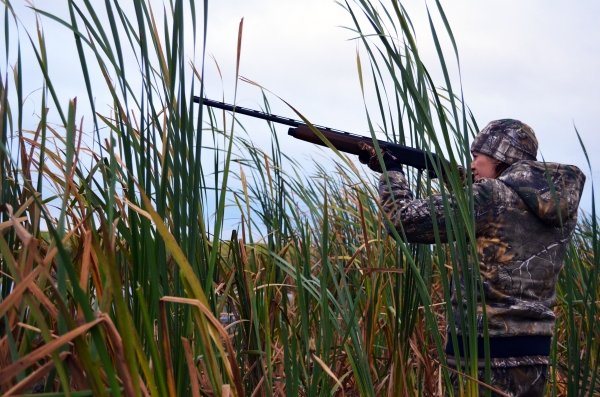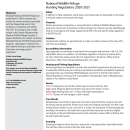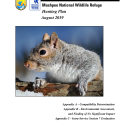
Hunting is an important wildlife management tool that we recognize as a healthy, traditional outdoor pastime, deeply rooted in America’s heritage. Hunting can instill a unique understanding and appreciation of wildlife, their behavior, and habitat needs.
Approximately 290 acres of the refuge is open to hunting. This area is divided between two parcels: Bufflehead Bay parcel in Mashpee (284.4 acres) and Conboy parcel in Falmouth (5.5 acres). Other land parcels within the refuge acquisition boundaries which are owned by partners including Mass Wildlife, Mass DCR, Falmouth Rod and Gun Club, and the town of Mashpee are open to hunting and fishing in designated areas following state regulations.
All hunters are required to adhere to both state and federal regulations. Hunters must possess a valid state hunting license and all applicable tags and stamps; however, an additional refuge-specific permit is not required.
No rabbit hunting is permitted on the refuge due to the presence of New England cottontails, a species of conservation concern.
Mashpee NWR is located in Massachusetts Wildlife Management Zone 12. Legal open seasons and bag limits are in accordance with state regulations, which can be found on the MassWildlife website.
As per Massachusetts state law, hunting is not permitted on Sundays.
Safety
In addition to State regulations, safety zones and closed areas are designated on the refuge to maintain safety on and around the refuge.
Firearms
Persons possessing, transporting, or carrying firearms on National Wildlife Refuge System lands must comply with all provisions of State and Federal laws. Persons may only use (discharge) firearms in accordance with refuge regulations (50 CFR 27.42, and specific refuge regulations in 50 CFR Part 32).
Vehicles and Parking
Licensed motor vehicles are permitted only on public use roads as shown on the map. ATVs and UTVs are prohibited.
Hunting Opportunities at Mashpee NWR
All hunts are conducted in alignment with State seasons and method of take (with the exception of night hunting, which is not permitted on the refuge).
Big Game (White-tailed Deer, Turkey)
Open on both parcels, in alignment with State seasons and method of take. Rifle and handgun not permitted.
Small Game (Squirrel Only)
Open on both parcels, in alignment with State seasons and method of take. Squirrel hunting is closed during deer shotgun season. Rifle and handgun not permitted.
Upland Game Bird (Pheasant, Quail, Ruffed Grouse, Crow)
Open on both parcels, in alignment with State seasons and methods of take. Closed during shotgun deer season. Only non-toxic ammunition is permitted for upland game hunting.
Migratory Bird (Sora, Virginia Rail, Wilson’s Snipe, Ducks, Geese, American Coot, American Woodcock)
Open on both parcels, in alignment with State seasons and methods of take. Only non-toxic ammunition is permitted for migratory bird hunting. The use of dogs is permitted for retrieving migratory game birds only.
Furbearer (Coyote, Fox, Raccoon, Opossum)
Open on both parcels, in alignment with State seasons and method of take. All furbearer hunting seasons are closed during shotgun deer season except coyote. Rifle and handgun is not permitted.
Other Rules & Regulations for Hunting at Mashpee NWR:
- Hunting hours are a half hour before legal sunrise to a half hour after legal sunset. Migratory game bird hunters may access the refuge 1.5 hours before legal shooting hours until 1.5 hours after legal shooting hours.
- Refuge hunters are allowed to place one tree stand or ground blind per refuge for any and all hunting seasons permitted. Hunters must mark tree stands/blinds with their state hunting license number in such a way that it is visible from the ground.
- All hunting materials including trail cameras, tree stands, or ground blinds may be put up the first eligible scouting day of the permitted season and must be removed by January 30th or 30 days after the end of permitted season.
Scouting can begin no earlier than four weeks prior to the opening day of permitted season from half hour before sunrise to half hour after sunset.
- Hunters are required to report harvests according to Massachusetts State regulations.
Prohibited Activities
- Possession of alcoholic beverages
- Night hunting
- Baiting or hunting over bait
- Camping and fires
- Trimming or cutting vegetation
- Searching for or removal of any natural items such as antlers, skulls, plants, historic and archaeological artifacts
- Driving of deer by any means
- Use of a spotlight or other artificial light to locate wildlife
- Use of electronic calls
- Marking of any tree, trail, or other refuge feature with flagging or paint
- Permanent tree stands, nails, screw-in steps, or other items that penetrate the outer bark of a tree
- Permanent ground blinds
- Firearms capable of firing centerfire rifle and pistol cartridge ammunition
- Possession of loaded firearm, discharge of firearm, or hunting is prohibited within 500 feet of any dwelling
- Discharge of any firearm or release of any arrow across roads or within 150 feet of road
- Hunter harassment or interfering with persons engaged in lawful activities
Accessibility Information
Equal opportunity to participate in and benefit from programs and activities of the U.S. Fish and Wildlife Service is available to all individuals regardless of physical or mental ability. For more information, please contact the U.S. Department of the Interior, Office of Equal Opportunity, https://www.doi.gov/pmb/eeo/public-civil-rights.

